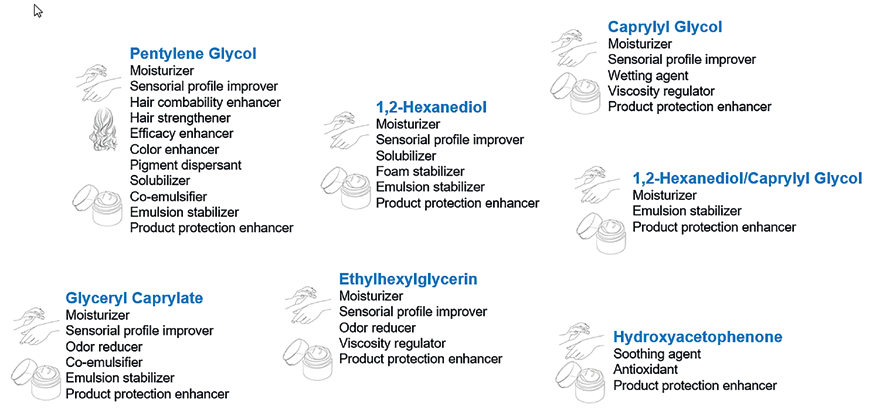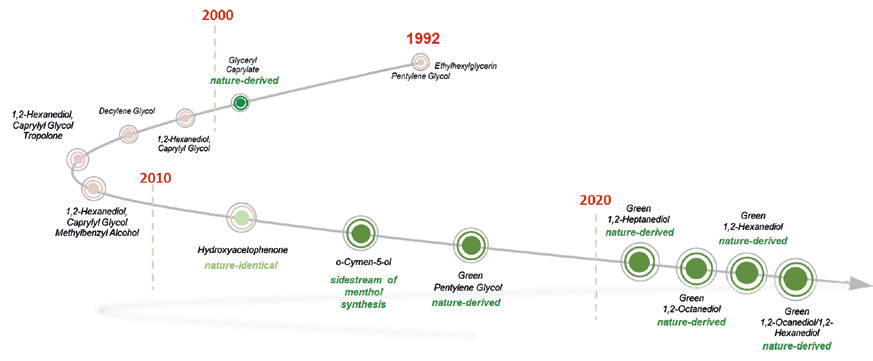
Modern Product Protection
Antimicrobial protection of cosmetic formulations is not only prudent but critical to ensure the safety of cosmetic products for the consumers’ health and to maintain their stability, performance, and esthetic appeal for the entire life. No matter whether it’s sitting on a shelf or being used by the consumer, the product must have a robust defense against all possible microbiological contamination and growth. For over a hundred years, this was managed with various preservatives dedicated to the single task of inhibiting microbiological growth. As scrutiny and controversy about the health effects of some of the conventional preservatives have increased, the choices have evolved towards safer alternatives. During the past couple of decades, multifunctional ingredients have emerged as product protection enhancers and have been gaining greater and greater traction. By enhancing the efficacy of the product protection system, they allow the use of milder preservatives and lower use levels significantly alleviating consumer concerns and improving product acceptance and safety.
Multifunctionals
With its launch in 1992, Pentylene Glycol (Hydrolite® 5) was among the first multifunctional ingredients to be used in cosmetics. Other multifunctionals have also been introduced, such as longer chain 1,2-alkanediols, from C6 to C10, as well as chemically different substances, such as Hydroxyacetophenone (SymSave® H), Ethylhexylglycerin (Hydrolex™ E), Glyceryl Caprylate (SymLite® G8) and blends containing Tropolone (SymDiol® 68T), and Methylbenzyl alcohol. As much as they differ in composition, their way of supporting product protection varies. What is common, however, is that these ingredients offer multiple primary benefits beyond product protection (Figure 1) and that they generally represent safe and non-controversial approaches.


Sustainability
Multifunctionals acquired their name for a good reason: they offer multiple benefits. They can be moisturizers, solubilizers, antioxidants, or can have other desired effects on the formulation or the skin or hair. In principle, this multitude of functions elevates the sustainability profile of multifunctionals over that of single-purpose ingredients, since they are able to replace several other ingredients in a formulation at the same time by fulfilling their functions simultaneously. Imagine, for instance, achieving stabilized emulsions with good skin moisturizing properties and superior skin feel with just one ingredient (e.g. SymDiol® 68). In addition, green chemistry principles can easily be applied to the production processes of several classes of multifunctionals (e.g., 1,2-alkanediols). Therefore, multifunctionals have already enjoyed a considerable sustainability advantage over most traditional ingredients. This has recently been further elevated by replacing the petroleum-derived raw materials with biobased ones.
Green multifunctionals
The cosmetic industry has long recognized the allure of natural or nature-derived ingredients. Natural extracts have always been part of the promise of healing, beauty and rejuvenation and have always had a place on store shelves and in consumers’ vanities. Such extracts, however, leave much to desire in antimicrobial performance. Truth be told, product protection has had a few limited green options for a couple of decades, such as nature-derived esters, including glyceryl caprylate. However, the very few choices of ingredients and chemistries did not afford sufficient versatility to accommodate wide-spread use. We are just beginning to experience the boom of biobased multifunctionals (Figure 2).
Sustainable sources
Coincidentally, it was pentylene glycol, a 5-carbon 1,2-alkanediol and the first 1,2-alkanediol multifunctional in cosmetics launched over 30 years ago that became the first 1,2-alkanediol to be made 100% green (Figure 2). It also happens to be one of the most versatile multifunctionals with an astonishingly high number of benefits (Figure 1). The unparalleled sustainability profile of the green version of this ingredient is due not only to the upcycling of the raw material bagasse, the waste product of sugar cane processing, but it has also been demonstrated that the production process itself can be done under remarkable sustainable conditions. The upcycling of bagasse offers a much needed and long coveted solution to utilize this food waste. The synthetic path is unique to the 5-carbon chain and can not be applied to longer chain green diols, whose inevitable arrival on the stage of green multifunctionals required the development of entirely different processes. This led to the launch of several green 1,2-alkanediols in quick succession: Caprylyl Glycol (1,2-Octanediol), 1,2-Hexa–nediol, and their blend (SymDiol® 68 green). While chemically analogous, each chain length offers unique properties and benefits for the consumer and for the formulator.
A few simple steps of transformation from plants to cosmetic ingredients open the path to more sustainable and consumer-friendly cosmetic formulations. Typical plant sources include palm kernel oil and coconut oil. Multifunctionals which are caprylic acid derivatives, such as glyceryl caprylate (SymLite® G8) or caprylyl glycol (Hydrolite® 8 green), as well as hexanoic acid derivatives, such as 1,2-hexanediol (Hydrolite® 6 green), use these sources. There are also plants that offer even greater sustainability profiles and can be considered ideal. Bagasse, that is sugar cane, was already mentioned. Castor bean is another example. This drought-resistant plant is extremely resilient and can be grown in arid climates where other plants, such as food crops, would struggle to survive, thereby providing opportunities to local farmers to put bread on the table for their families. This plant is the source of multifunctionals derived from undecylenic acid and, by upcycling the side product, heptanoic acid derivatives, such as 1,2-heptanediol (Hydrolite® 7 green). Other plant sources are also being explored as alternative sources for existing multifunctionals and potential sources for new ingredients.
100% green, 100% efficacious
Trivially, all of the characteristics, chemical and physical behaviors of biobased multifunctionals are identical to their petroleum-based predecessors, since they are chemically identical molecules. This also means that they have the same efficacy in all regards, whether it’s skin benefits, hair benefits, formulation benefits, or product protection enhancement. Some of these biobased multifunctionals, consequently, are already well known to formulators. We already know a lot about their benefits, safety, properties, and how to formulate with them. Yet, they offer naturality, which enables a formulator to create greener formulations or to replace synthetic single-purpose ingredients with them.

Figure 3: Challenge test results (cfu vs. days) of 1% 1,2-Hexanediol + 0.3% Potassium Sorbate in an O/W anionic emulsion.
E. coli, P. aeruginosa, S. aureus, C. albicans, A. brasiliensis

Figure 4: Challenge test results (cfu vs. days) of 0.5% 1,2-Hexanediol/Caprylyl Glycol blend + 0.2% dehydroacetic acid in an O/W non-ionic emulsion.
E. coli, P. aeruginosa, S. aureus, C. albicans, A. brasiliensis

Figure 5: Challenge test results (cfu vs. days) of 0.5% Glyceryl Caprylate + 0.25% sodium benzoate + 0.25% potassium sorbate in a shampoo formulation.
E. coli, P. aeruginosa, S. aureus, C. albicans, A. brasiliensis
Conclusions
With the recent launches of several nature-derived multifunctionals, we are approaching a threshold of diversity that can enable formulators to assemble wide enough ranges of green ingredients to produce formulations, including the product protection systems contained within as well, with a Natural Origin Content (NOC) of nearly 100%, for almost all formats. Like the Cretaceous period in Earth’s history was the explosion of green and life in general, we are about to enter the era of green cosmetics through the evolution of green multifunctionals. This green boom, however, will not promote fossil fuels. Quite the contrary. As we turn from raw material sources under the ground to above ground, cultivation on lands unsuitable for food crops and upcycling are becoming important sustainability aspects.



